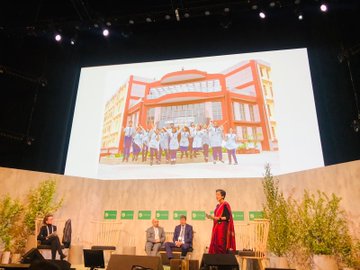Delhi has shown in the last 7 years that a city of 30 million residents can strive towards equity, inclusion and sustainability while showing resounding economic growth: Atishi
Government schools have been getting better results than private schools for the last 4 years in Delhi: Atishi
The per capita income of Delhi is 3 times higher than the rest of the country and state GDP has increased 150% in the last decade: Atishi
Delhi Government, with its efficient budget management policies and fiscal prudence has been able to increase government subsidies as well as expenditure on education and healthcare consistently: Atishi

NEW DELHI
MLA Atishi addressed the ICLEI World Congress 2022 at Sweden’s Malmo Summit today and highlighted the transformation of Delhi under the Kejriwal Government. Talking about the transformation of the state under the Delhi Model, she said that if Delhi – a city with 30 million residents – can move towards equity and inclusion, then I believe that every city in the world can do the same. MLA Ms Atishi said, “Delhi has shown in the last 7 years that a city of 30 million residents can strive towards equity, inclusion and sustainability while showing resounding economic growth. Government schools have been getting better results than private schools for the last 4 years in Delhi. The per capita income of Delhi is 3 times higher than the rest of the country and state GDP has increased 150% in the last decade. Delhi Government, with its efficient budget management policies and fiscal prudence has been able to increase government subsidies as well as expenditure on education and healthcare consistently.”

MLA Ms Atishi said, “As we gather today at the Malmo Summit to discuss equity and inclusion, we must remember that we live in a world of inequity and exclusion. 1 in 3 people in the world do not have access to clean drinking water. Over 200 million people in the world are going to be unemployed in 2022. 85% of the world’s population put together does not have access to even half the resources that are available to 1% of the world’s population. Cities – especially in the Global South- face some of the deepest inequalities in this world. Access to basic necessities – water, electricity, sanitation, education and healthcare – is not assured to many of those who live in cities across the world. And as the population in cities grows at an unprecedented pace, these inequalities and exclusions are only becoming deeper. As we look to create more equitable and inclusive cities, we are often asked – will equity, inclusion and sustainability come at the cost of economic growth?”

She added, “Delhi has shown in the last 7 years that both are possible – that a city of 30 million residents can strive towards equity, inclusion and sustainability while showing resounding economic growth. In 2015, a new party came to power in Delhi, the ‘Aam Aadmi Party’, the Party of the Common Man, under the leadership of Chief Minister Shri Arvind Kejriwal. We faced many challenges. Power cuts were frequent, power tariffs were extremely high, a limited population had access to piped drinking water and proper sewerage facilities, Public healthcare systems were almost non-existent. The public schools, with almost 1.5 million students, lacked the most basic facilities such as a separate toilet for boys and girls and a high degree of teacher absenteeism. Majority of the population lived in areas deemed to be “Unauthorised” and hence were bereft of any development. In the last 7 years, the Arvind Kejriwal government in Delhi has turned all this around.”
She continued, “Government schools – that in 2015 looked dilapidated. The very epitome of inequity and exclusion, 7 years later look better than any private school of the country ever has. Government schools have been getting better results than private schools for the last 4 years. Last year, two hundred thousand students shifted from private schools to government schools. Today all of the city’s population have access to Primary Health care centres called “Mohalla clinics” where the citizens get free consultations from a qualified doctor and free tests and medicines. More than 50 million such consultations have happened in the last 5 years. We now have 24*7 electricity, the lowest electricity tariffs in the country, with a major shift towards renewable sources of energy. More than 1,500 residential areas have got piped water supply for the first time; more than 500 residential areas have been connected to the sewerage network for the first time.”
The MLA further said, “All this has been achieved with increasing revenues and budget sizes at the same time. The total budget of Delhi has increased from Rs.300 billion (in 2015) to 750 billion (in 2022). And every year, the Delhi Government has increased its revenues and had a revenue-surplus budget. The per capita income of Delhi is 3 times higher than the rest of the country and state GDP has increased 150% in the last decade. We believe that one of the most important aspects of sustainable development is sustainable finances. The Delhi Government, with its efficient budget management policies and fiscal prudence has been able to increase government subsidies as well as expenditure on Education and healthcare consistently. And this is what has led to economic growth in Delhi. If Delhi – a city with 30 million residents – can move towards equity and inclusion, then I believe that every city in the world can do the same.”
